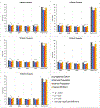Longitudinal assessment of quality of life in indolent non-Hodgkin lymphomas managed with active surveillance
- PMID: 36120910
- PMCID: PMC9877126
- DOI: 10.1080/10428194.2022.2123225
Longitudinal assessment of quality of life in indolent non-Hodgkin lymphomas managed with active surveillance
Abstract
There are limited data describing the impact of active surveillance on longitudinal health-related quality of life (HRQoL) in patients with indolent non-Hodgkin lymphomas (NHL). A cohort of untreated indolent NHL patients completed FACT-LYM questionnaires at 6, 12, 18, 24, and 36 months after diagnosis. Longitudinal FACT-LYM scores were analyzed by ANOVA and generalized linear mixed models. Indolent NHL scores were compared to norm general population scores. A total of 52 patients were identified, of which 46 (88%) remained on active surveillance at 36 months. There was no significant change in any of the FACT-LYM scores over 36 months. As compared to the general population, indolent NHL patients had higher, clinically meaningful scores in physical, functional, and social well-being, but not emotional well-being. Patients with indolent NHL on active surveillance have globally preserved HRQoL for up to 3 years after diagnosis. Emotional well-being continues to be an unmet need during active surveillance.
Keywords: Patient-reported outcomes; active surveillance; non-Hodgkin lymphoma; quality of life.
Conflict of interest statement
DISCLOSURE OF CONFLICTS OF INTEREST
The authors have no relevant conflicts of interest to disclose.
Figures

References
-
- Brice P, Bastion Y, Lepage E, et al. Comparison in low-tumor-burden follicular lymphomas between an initial no-treatment policy, prednimustine, or interferon alfa: A randomized study from the Groupe d'Etude des lymphomes de l'Adulte. Journal of Clinical Oncology. 1997;15(3):1110–1117. doi: 10.1200/jco.1997.15.3.1110 - DOI - PubMed
-
- National Comprehensive Cancer Network. B-Cell Lymphomas (Version 5.2021). https://www.nccn.org/professionals/physician_gls/pdf/b-cell.pdf. Accessed December 1, 2021. - PubMed
MeSH terms
Grants and funding
LinkOut - more resources
Full Text Sources
Research Materials
